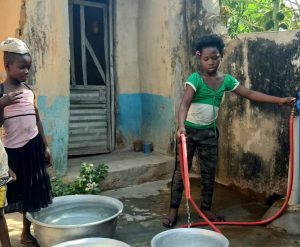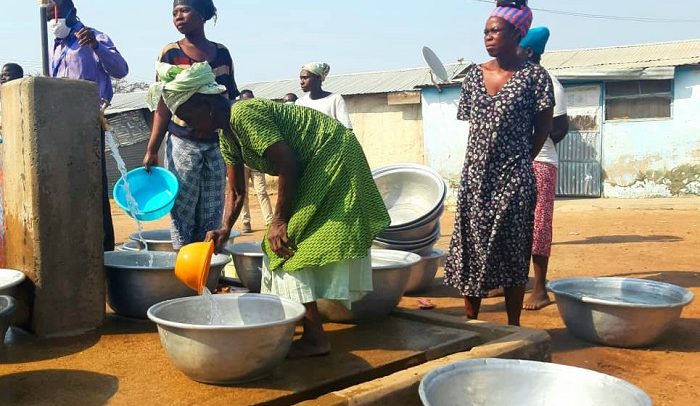Women at the shared community standpipe fetching water
Potable water is a basic requirement for health and wellbeing of individuals and families, but for the people of Amanhyia in the Suhum Municipality of the Eastern Region, access to potable water was a challenge until recently.
The community with over 4,000 residents previously, relied on a remote source of water to meet their daily needs.
“We use to walk long hours to get water for cooking, washing and other house chores,” says 39-year-old Abena Amofa, a mother of three and a resident of Amanhyia.
She says her two children aged 15 and 12 usually fetched the water for the family’s daily use. “It is the second thing they did after sweeping the compound every morning. But now that we have been connected to the water supply system, they will not have to spend a lot of time fetching water,” she says.
Abena adds that with the new water system which has three major water points that can be accessed by community members, ‘we will now have improved quality of life.’
Impact on Children
The unavailability of potable water supply affects children especially those in water vulnerable hotspots.
The United Nations Children’s Fund (UNICEF) estimates that one in five children globally does not have enough water to meet their everyday needs with communities living in these areas depending on surface water, unimproved sources, or water which can take more than 30 minutes to collect.

Children fetching water from a household standpipe
“Children are the biggest victims. When wells dry-up, children are the ones missing school to fetch water. When droughts diminish food supplies, children suffer from malnutrition and stunting. When floods hit, children fall ill from waterborne illnesses. And when water resources decline, children cannot wash their hands to fight off diseases,” says UNICEF Executive Director, Henrietta Fore.
In Ghana, 1 in 5 children experience high/extremely high-water vulnerability and about 4 in 5 people may be drinking faecally contaminated water at the point of use, says UNICEF latest report on water security.
Again, rapid population growth, urbanization, water misuse and mismanagement, climate change and extreme weather events is reducing available quantities of safe water and exacerbating water stress.
Already, women and girls around the world collectively spend an estimated 200 million hours a year – or around 23,000 years – walking to fetch water, says the UN agency adding that for the one in ten of the world’s population that do not have clean water close to home, the hours spent collecting water or the time needed to recover from waterborne illnesses caused by dirty water, robs entire communities of an opportunity to build a better future.

“We have to act now both to address the water crisis and to prevent it from getting any worse,” said Fore. “We can only achieve water security for every child through innovation, investment and collaboration, and by ensuring services are sustainable and resilient to climate shocks. For our children and our planet, we have to act.”
Climate Change Impact on Water Supply
WaterAid believes the impact of climate change on people’s water supplies is being overlooked and it threatens to put progress on bringing clean water to all back decades unless urgent action is taken to help the world’s poorest communities adjust to changing weather patterns.
In its latest report, “Turn the Tide: The state of the world’s water 2021” the international development organisation shows how people are losing access to clean water as longer droughts dry up springs, seawater infiltrates groundwater supplies and landslides take out water pumps.
It stresses that investing in water systems that provide a reliable supply whatever the weather, is a frontline defence against the impact of climate change.
“Climate change acts as a threat multiplier, exacerbating problems caused by poor management of water resources, lack of political will, and inadequate investment. With the current climate scenario, it is predicted that water scarcity will displace between 24 million and 700 million people, by 2030.
Currently only 5% of total global climate funding is spent on helping countries adapt to their changing climate, and that money is not targeted at the communities most vulnerable to climate change,” says WaterAid.
The investment in ensuring that everyone no matter where they live has a reliable and safe water source to help make communities become more resilient to climate change, is completely inadequate to the growing crisis – some of the most climate vulnerable countries only receive $1 per person per year for investment in water, says the international organization.
Acting Country Director, WaterAid Ghana, Jesse Coffie Danku, explains that the world’s poorest people, who’ve contributed the least to the climate crisis, are living with its most destructive impacts as climate change is making it more difficult for vulnerable people to rely on having clean water when they need it.
“Unless communities have access to a reliable source of water, people’s health will suffer, and they’ll be burdened with spending more and more time searching for water, taking away the opportunity to create a better life and escape poverty.
“Government needs to step up now, commit to recognise the critical role clean water has in helping communities cope with climate change and recovering quickly from related extreme weather events,” he urges.
Government’s Efforts In Addressing Access to Potable Water Supply
Meanwhile, the Ministry for Sanitation and Water Resources (MSWR), has announced a $1.4 billion investment in 14 urban water supply projects and six major rural water supply projects in the country.
According to the sector minister, Cecilia Abena Dapaah, when completed, these projects are expected to benefit about 4.87 million Ghanaians.
As part of the project, the government promises to increase investments in the roll-out of climate-resilient water infrastructure systems, which will reduce wastage in fresh water use; thus, a shift towards environmentally sustainable policies, taking into account interconnection among ecological systems and reducing pollution.
It also promises to promote efficient water treatment technologies that reduce the use of water and improve the quality of water, and in effect, ensure that citizens have the water they need to lead healthy, happy and protected lives.
Madam Dapaah notes that Ghana had made significant progress in the provision of basic drinking water services to its citizenry, and indicated that by studies from the Ghana Multiple Indicator Cluster Survey eight out of every 10 household population in the country used at least basic drinking water services.
Statistically, the population having access to improved drinking water sources increased from 78% in 2017 and to 81% in 2019; while the population having safely managed drinking water sources also increased from 27% in 2017 and to 36% in 2019.
This, she remarks, “is in sync with government’s agenda of bringing water to the doorsteps of the people.”
Shared Responsibility
In the face of threats posed with regard to the availability of water for domestic, industrial and other purposes, the Sanitation and Water Resources Minister intimates that “government’s policy response to safeguard our water resources for everyone and for every sector of the economy is that of a shared responsibility of us all.”
“As a country we have a duty to make decisions that support only the sustainable use and management of water; decisions that prescribed and promoted remedial interventions meant to reduce all sources of pollution, including illegal mining and the disposal of liquid and solid waste; decisions that promoted education and public awareness about the fundamental value of water and its essential role in all aspects of life; while taking into account the multiple and diverse groups and interests at stake in all decisions affecting water in ways that would ensure equity, transparency and inclusiveness,” she adds.


